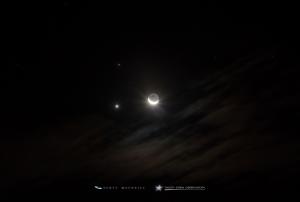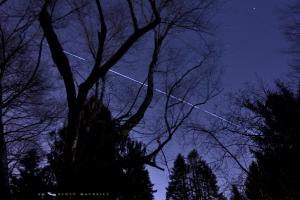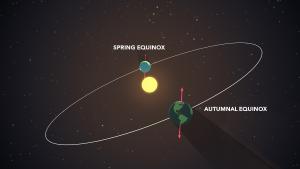Celebration of Space - March 13, 2020
This coming Wednesday, March 18, 2020, fabulous conjunctions of Jupiter, Saturn, Mars, and at times the Moon, commence. This isn’t the first conjunction this year involving these bright objects, though conjunctions will become much more frequent this week, and will continue over the year. Wednesday morning’s conjunction will involve Jupiter, Mars, the 30% waning crescent Moon, and Saturn. Set your alarm for 5:00 am, step outside and look to the SE. Jupiter, Mars and the crescent moon will all visibly sit within 2° of each other, with Saturn hanging out about 7° to the east. Considering the Moon is in a crescent phase, Earthshine will be clearly visible, which is when the nighttime side of the Moon is subtly illuminated by sunlight reflecting off of Earth. If the sky is clear, this will be a fabulous conjunction. So don’t miss it!
If Wednesday morning’s conjunction just isn’t enough astro-geekery for you, then you have another fabulous conjunction happening on Friday morning, March 20, 2020. This time, Mars and Jupiter will be hosting a celestial dance. Set your alarm for the same time, 5:00 am, step outside, and look to the SE. Jupiter will be sitting about ½ degree above Mars, with Saturn chilling about 7° to the east. This conjunction is actually three days long, centering on March 20th, which will be the best morning to view. Though if you can, step out at the same time all three mornings to see Mars swing past Jupiter in the sky. Conjunctions will continue into next week and we will keep you informed. Check out our Facebook or Twitter (@FrostyDrewOBSY) for updates on these conjunctions. If you happen to catch a photo of these stunning celestial dances, please post them on our Facebook, either as mentions, check-ins, or to the Visitor Posts section, and we’ll share them on our timeline. Now get out there and welcome a fabulous year of conjunctions!
On Tuesday, March 17, 2020, the International Space Station (ISS) will return to the evening sky over the US, offering up fabulous visible passes every night over New England. Due to the ISS’s 51° inclined orbit (as it relates to Earth’s equator), we only see the ISS in periods. Either in the morning, evening, or not at all. Though the station does pass over our location every day. To see the station, it has to be in sunlight, while us (the observers) are in twilight or later. Here are some notable passes happening this week:
Tue, Mar 17 at 8:09 pm ET, starting in the S, rising to 20°, heading towards the SSE and into orbital sunset.
Wed, Mar 18 at 8:57 pm ET, starting in the WSW, rising to 36°, and into orbital sunset
Thu, Mar 19 at 8:09 pm ET, starting in the SW, rising to 64°, heading towards the ENE and into orbital sunset. ← best pass!
Orbital sunset happens when the ISS orbits into Earth’s shadow, essentially sunset on the station. This is when we will lose sight of the ISS. It will appear to slowly fade out of view. The times posted are specific for Southern New England, and generally applicable for the Northeast. For daily pass times of the ISS and other bright satellites, visit our daily satellite tracker. For pass times specific to your location, visit NASAs Spot the Station. Now get out there and catch a view of humanity’s only space based residency, and get excited about the upcoming return to the Moon via the Artemis mission.
On Thursday, March 19, 2020 at 11:50 pm EDT, Earth’s equator will intersect with the ecliptic (the path the Sun takes across the sky) marking the Vernal Equinox, and the start of spring in the Northern Hemisphere. At this time the Earth arrives at the point in its orbit where it is neither tilted towards or away from the Sun. This results in equal amounts of daylight for corresponding locations north and south of the equator, with the Sun passing directly overhead (at zenith) when viewed along the equator at Noon. Thursday also marks a switch in daytime length, to a period of the year where the days are longer than the nights. So take a moment this coming Friday to step outside and welcome the mosquito pending, mud laden, pollen attack of spring, and take solace in the heat induced craziness that’s just around the corner, including late sunsets, picnics, beach days, and fabulous nights under the Milky Way. Happy Vernal Equinox!
- Author:
- Scott MacNeill
- Entry Date:
- Mar 13, 2020
- Published Under:
- Scott MacNeill's Columns





